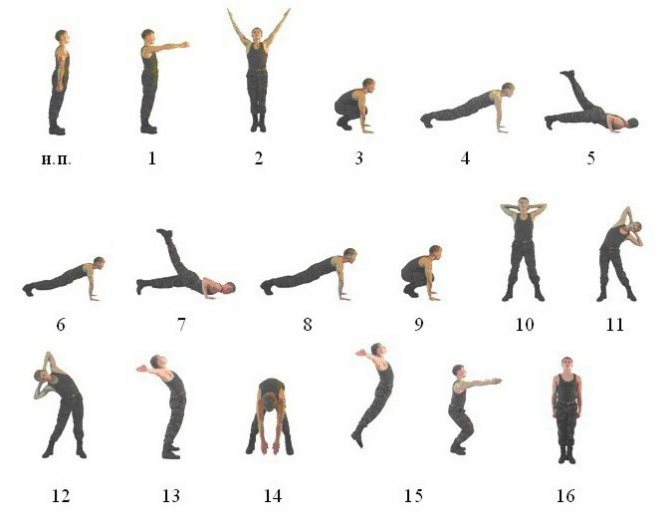Circuit training is a good option to lose weight while following a healthy diet. The muscles make the most of the glycogen stored in the body and encourage the body to use fat stores as an energy source.
- Circuit training consists of 6 to 10 exercises, which are done one after the other.
- Each exercise is performed a certain number of repetitions or in a certain interval of time.
- Exercises within one cycle are separated by a short rest period, between cycles a longer rest period.
Total cycles performed during training varies from 2 to 6 and depends on:
- on the level of physical fitness – beginner, intermediate or advanced;
- on the duration of the training stage – preparatory or before the competition;
- from the goal of training – increasing endurance, losing weight or drying.
Principles of building circuit training programs
The scheme of exercises for circuit training should be constructed in such a way as to work out each part of the body in one cycle in a specific order, for example:
- whole body;
- upper part;
- lower part;
- body.
Write 3–4 cycles of 6–10 exercises on a piece of paper that you can do with the resources available. In each cycle, ensure that there are no two exercises in a row on the same muscle group, for example, push-ups should not follow the lifting of weights overhead
It is very important to warm up at the beginning of the workout and cool down at the end
The duration of each exercise in a cycle is estimated in one of two ways:
- based on a fixed time, for example, 30 seconds;
- as half the number of repetitions of an exercise that a person can perform in 60 seconds, applying 100% effort.
If your workout is based on reps, then retest every 4 weeks to determine the maximum number of repetitions of each exercise in 60 seconds to ensure progress.
The workout can be organized into a 4-week cycle: easy, medium, hard week and test / recovery week. The load is controlled by changing the number of exercises, duration of execution, number of sets and recovery time.
Sequence
Stand up straight, stretching up from crown to heels.
- Take your arms back.
- Rise on your toes with your arms up.
- Lower your elbows down.
- With your left foot, lunge to the left, arms spread apart.
- We return to the position with bent elbows and palms brought to the shoulders (how about 3).
- Lunge to the right with the right foot, spread our arms out to the sides.
- Return to the position with bent elbows, palms to shoulders (both on 3 and 5).
- Leap with legs wider than shoulders, arms up in the lock.
- Bend with with straight legs, we put our hands behind the legs, try to push the body back as far as possible.
- We abruptly come out of the slope and take our left hand back along with the rotation of the body. We also turn our head, look at the left palm.
- We return back to the slope, similar to the position at the expense of 9.
- We leave the slope and take our right hand back with a turn of the body, look at the right palm – we repeat the count of 10 on the right side.
- We return to the slope again.
- We leave the slope immediately into the squat, the arms, like the hips, are parallel to the floor, we stretch our back, do not round it.
- Leap out of the squat: legs are wider than shoulders, arms up to the sides, looking up.
- Jump starting position, standing at attention.
Circuit training complex
Sometimes, when doing fitness in the gym, you need to change the training program and focus on burning fat, this can be helped by a circular training method. The essence of circular training is to consistently perform exercises for all muscle groups with a minimum rest time. In one circle, you should complete as many exercises as possible in the minimum amount of time. Here is one example of exercises for a 20-minute circuit training.
An example of a circuit training
Please note that all exercises are performed with light weights with maximum repetitions in a short period of time and a minimal pause between exercises. 1
Pull-ups – maximum reps in 1 minute
- Pull-ups – maximum reps in 1 minute
- Push-ups or bench press – maximum in 2 minutes
- Squat – 1 min.
- Exercise bike – 4 min.
- Dips – 1 min.
- Lunges on each leg – 2 min.
- Lifting the barbell or dumbbells for biceps – 1 min.
- Active walking on a treadmill – 4 min.
- Extension of the arms on the vertical block (for triceps ) – 1 min.
- Squats with a barbell – 1 min.
- Row of the vertical block to the chest (for the broadest muscles of the back) – 1 min.
- Twisting on bench or on the floor (for abdominal muscles) – 1 min.
If you coped with these exercises easily enough in 20 minutes, then you are a “cucumber” and you can repeat the circle again or perform it in reverse order
As you can imagine, it is not so difficult to compose a complex of different variations in intensity, time and exercises for a circuit training about. It is important not to repeat exercises on the same muscle groups, alternate the upper and lower body
Circular workout for weight loss
If your goal is to lose weight, then a circuit training of cardio and strength training (as shown above) will help speed up your metabolism and burn fat more efficiently. It is believed that combining strength and aerobic exercise in one workout will not kill two birds with one stone (mass and fat burning), and I agree with that. But we are now talking about circuit training, and this is a completely different method – the method of high-intensity drying of the body.
To achieve the best results in losing weight, in addition to the above-described circuit training complex, it is important to maintain proper balanced nutrition. The law of weight loss is to spend more calories than you get
One significant disadvantage of the circular method is the long recovery time after training.

Complex floor exercises
We accept the starting position.
- Stretch our arms forward.Stand on our toes, raise our arms, stretch our whole body up.
- We lower our arms, directing our elbows down and pull the shoulder blades well.
- Raise our arms up, go into a shallow deflection in the thoracic region.
- Hands on knees, squat.
- We get up and sharply extend our arms to the sides and a little back, opening the chest.
- Squat with hands on knees (repeat count 5).
- From a jump squat, we put our legs wider shoulders, keeping our hands on the belt.
- Take the left hand back, unfolding the body.
- Return to the position of the hand on the belt, body straight.
- Take the right hand back together with the body an head, look at the hand.
- Return to p Position with hands on the belt.
- Bend down, without changing the wide position of the legs.
- Rise from the bend and lift your arms throgh the top sharply to the sides, how about 6.
- Repeat count 13 – tilt down.
- With a jump, take the starting position at attention.
Sequence
As in the previous cases, assume a standing position.
-
- Stretch your arms forward.
- With a jerk, move your arms over the top to the sides back, open the chest.
- We jump into a deep squat, touch the floor with our hands.
- We jump into the plank: the body is straightened, the lower back is not collapsed, the weight is evenly distributed between the arms and legs, heels from behind it is like pushing an invisible wall.
- From the plank we raise our left leg up, pull the toe, turn our head and look to the left, keep our balance.
- Return to the plank.
- Raise your right leg up and, turning your head, look to the right.
- Return to the plank.
- From the plank, jump back into a deep squat, keep your hands on the floor.
- Leap out of the squat, legs are wider than shoulders, arms behind the head, elbows to the sides.
- Bend to the left, pull down with the left elbow, and with the right in the opposite direction, make movements in the same plane.
Tilt to the right by repeating We are identical to movements on the count of 11 – we stretch our right elbow down.
- Opening our arms to the sides, we slide from a standing position into a tilt back, slight deflection in the thoracic region, do not strain the lower back, palms open and stretch back.
- From the deflection, bend forward, stretch downward with straight, widely spaced legs.
- Jump out of the slope, bringing our arms back through the sides, body, on the contrary, protruding forward. We also stretch back with our legs.
- From a jump over a light half-squat with arms extended forward, we return to the starting position.
If you want to do complexes as a regular workout, then focus on your overall athletic performance. If you are a beginner, take a set of floor exercises 1, if you have sports experience – 2 or 3.
- 1 repetition means doing all 6 exercises in a row,
- 1 series means fulfilling the number of repetitions provided for in each series for a given day (for example, on day 6 we perform 3 series of 6 repetitions, therefore, we perform 18 repetitions in total: the first series – 6 repetitions, the second series – 6 repetitions, third set – 6 reps).
This plan is just an example that you can modify to adapt to your needs.
DEFINITION OF THE EXERCISE SYSTEM. SYSTEM OF EXERCISES FOR FORMING SPEECH SKILLS.
The main form of organizing activities is exercises. Exercise is a multiple repetition of the same type of operations or actions, which is based on awareness and is accompanied by control or self-control.
The use of certain exercises requires an understanding of what this exercise is aimed at, what place in the system of exercises it occupies and what is the result of its implementation.
Exercises should form a system. Exercise system is such an organization of educational activities, which assumes a certain sequence of exercises, taking into account the increasing language and operational difficulties.
Requirements to the exercise system:
1. The execution of the action must be expedient (correspond to both the set goals and the nature of the phenomenon);
2. The sequence should correspond to the stages of the formation of skills and abilities (from imitative exercises – to independent production on any stimulus).
Requirements for exercises:
- Tasks for exercises should be communicative character. Those. not “Instead of dots, insert …”, “Use the words given in brackets, in the required form …”, “Make sentences with words …”, but “Express your agreement / disagreement with …”, “Express your doubt in …”, ” Please specify … “.
- Exercises should be situationally related: to train a particular grammatical structure, those situations should be selected in which this structure actually functions in speech. For example, to the question Do you have a dictionary? – the answer is “No” or “Unfortunately, no”, not “No, I do not have a dictionary.”
- Exercises should be structured so that they are relatively error-free and fast. For example, it is impossible, for example, to start training the use of the construction “who has nothing” with exercises like “Tell me that you don’t have what you are asked about”: – Please give me your phone number. – Unfortunately, I don’t have a phone. From the very beginning it is better to suggest the following: “Ask the interlocutor again, expressing your surprise. Ask where is the object in question “: -I do not have a watch. – No clock? Where are they?

